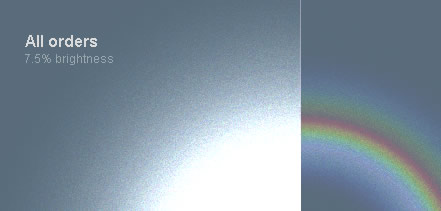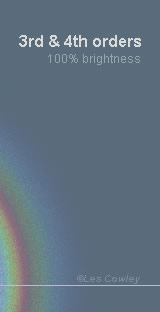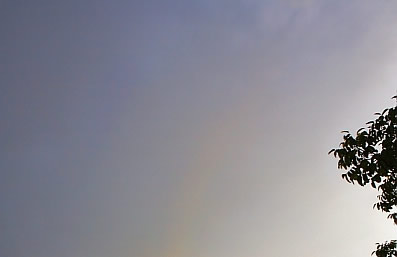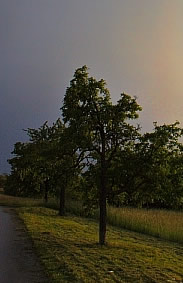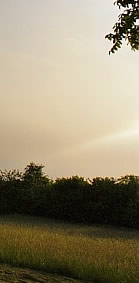
OpticsPOD
What's New
Rays & Shadows
Water Droplets
Rainbows
Not a rainbow!
Primary Bow
Secondary Bow
A's Dark Band
Other Orders
3rd & 4th
5th & 6th
Zero Order Glow
Supernumeraries
Red Bows
Rainbow Wheel
Dew Bow
Sea Spray Bow
Glass Bead Bows
Reflection Bows
Twinned Bows
Cloud Bows
Moon Bows
Image Gallery
Simulators
Ice Halos
High Atmosphere
Links & Resources
Search - Index
123456789012345678
| 3rd & 4th Order Rainbows |
|
3rd & 4th order rainbows. This BowSim simulation, made by tracing several hundred million rays through a raindrop, looks towards the sun. On the left is an unfiltered view. All that can be seen is the white glare of the zero order glow surrounding the sun. The filtered view at right shows only the rays making the 3rd order (inner) and 4th order (outer) rainbows. |
|
The tertiary bow's total brightness is 24% of the primary bow. We might therefore think
that it ought to be easily visible. There are severe difficulties: (1)
its light is swamped by that of rays that pass through raindrops
without any internal reflection. These generate an intense
glare around the sun, the
zero order glow, (2)
the tertiary is broader than the primary
and secondary, thus its luminosity per unit solid angle of sky
is correspondingly less, (3) glare and scattered light from the nearby sun interferes.
Großmann's 3rd order rainbow - The first known image. Star field calibration and computation of the sun position and angular properties of the image verified that the coloured arc was indeed the long sought tertiary rainbow. Images ©Michael Großmann, shown with permission Image them yourself
|
| * | D E Pedgley reported sighting the 3rd order bow in Nairobi and described it in Weather (Weather 41, 401 (1986)) "Whilst in Nairobi recently I had the good fortune to see a tertiary rainbow. On 21st May 1986 at 17.55 a new shower cloud had just started to rain out over my hotel in dense curtains of medium sized drops brilliantly lit by the low sun. From the balcony of my fourth floor room I could see not only a bright primary, accompanied by a moderate secondary, but also a weak bow in the direction of the sun, which was conveniently shielded by the side of the building. The bow was scintillating but distinct for two or three minutes. It was about the same size as the primary bow, with red on the outside and green on the inside." |
